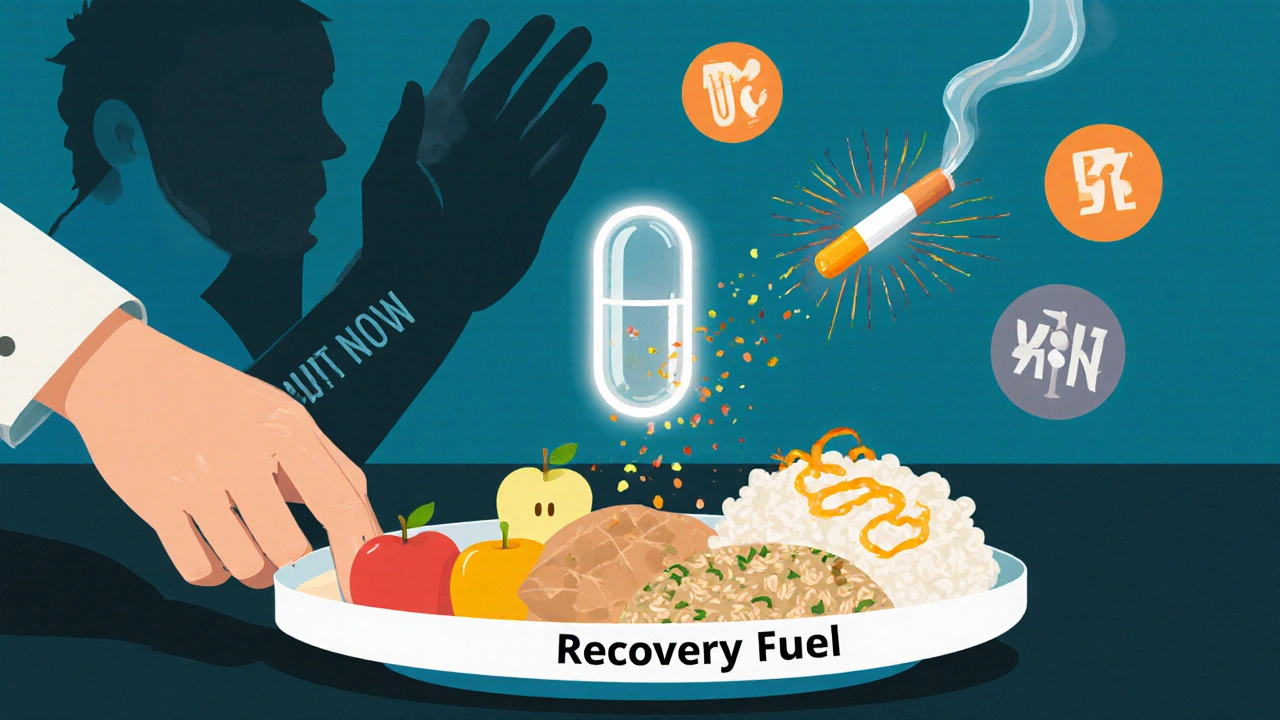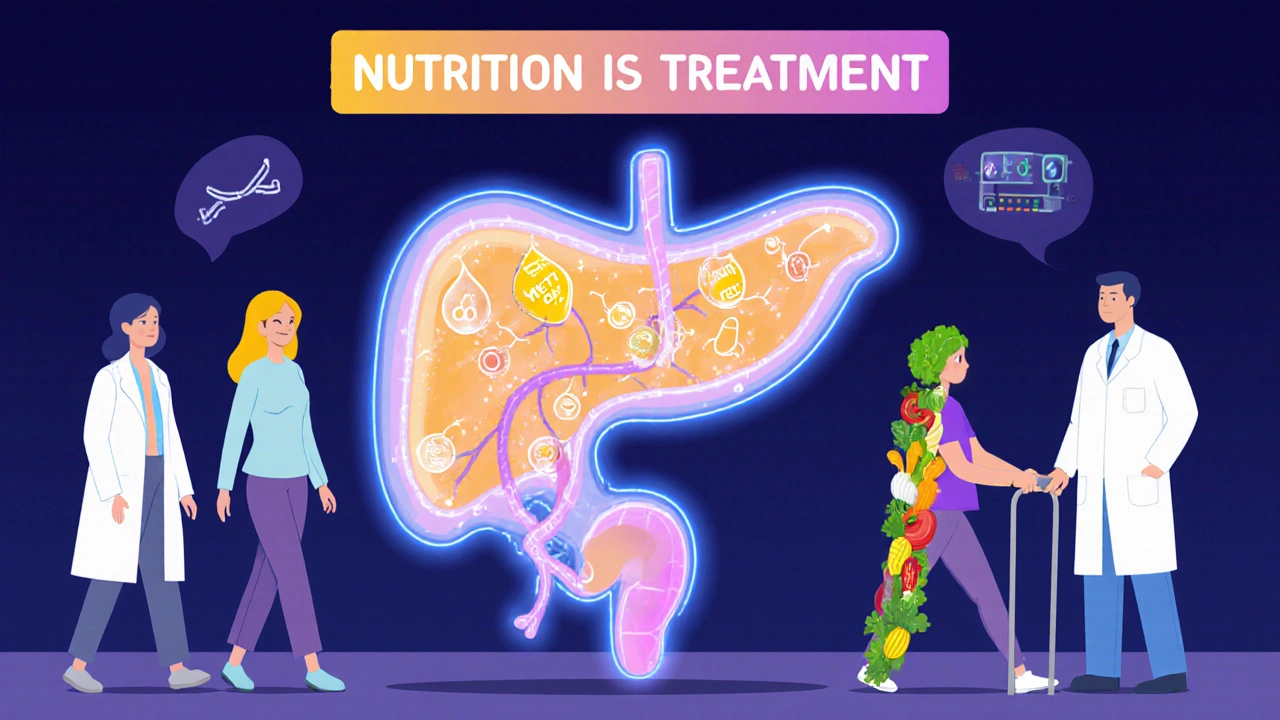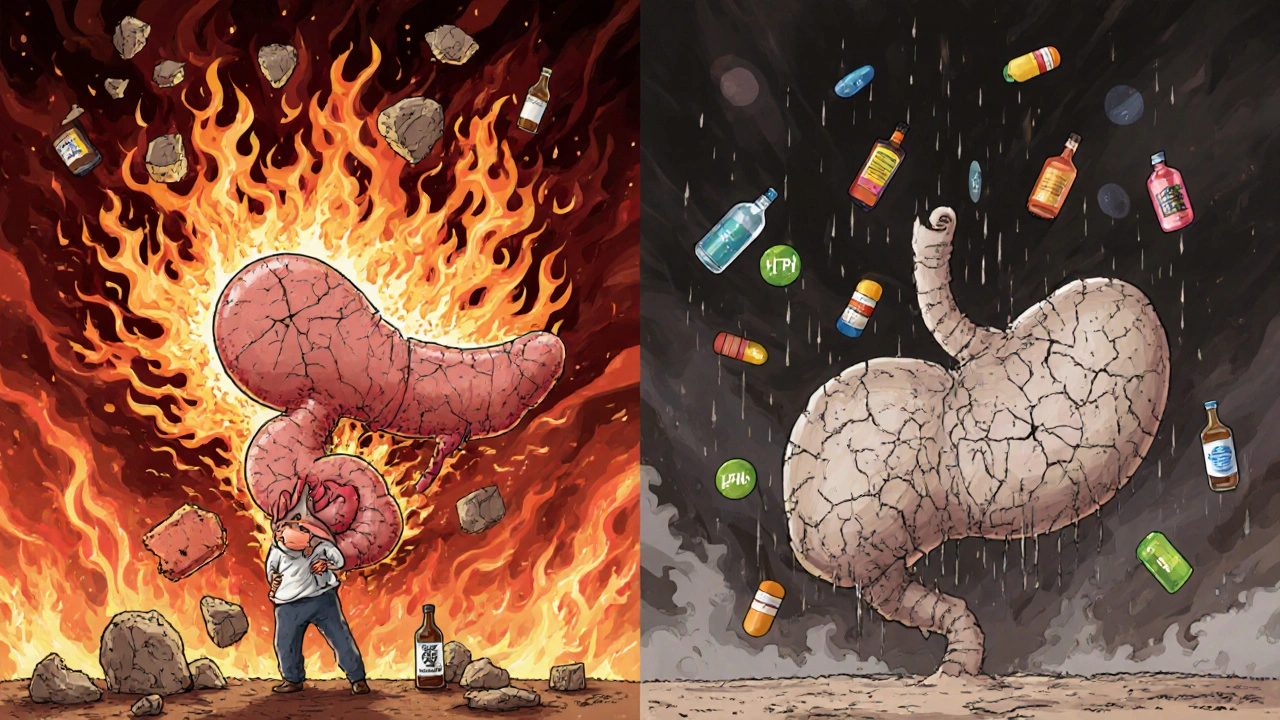When your pancreas inflames, it doesn’t just hurt-it disrupts everything. Digestion slows, blood sugar swings, and food that once felt safe can trigger agony. Pancreatitis isn’t one condition. It’s two very different diseases with the same name: acute and chronic. One comes on fast, often after a night of heavy drinking or a gallstone attack. The other creeps in silently, eating away at your pancreas over years. And whether you’re dealing with the sudden flare or the long-term damage, nutrition isn’t just helpful-it’s the foundation of recovery.
Acute Pancreatitis: The Sudden Fire
Acute pancreatitis hits like a storm. One moment you’re fine. The next, you’re doubled over with sharp pain in your upper belly, radiating to your back. Nausea, vomiting, fever-these aren’t just bad stomach bugs. They’re signs your pancreas is digesting itself. That’s what happens when digestive enzymes, meant to break down food in the small intestine, get activated too early-inside the pancreas. The organ starts tearing itself apart.
Most cases (about 80%) are caused by gallstones or alcohol. The rest? Sometimes it’s medications, high triglycerides, or even unknown reasons. Doctors diagnose it with three things: your pain pattern, blood tests showing lipase or amylase levels three times higher than normal, and a CT or ultrasound showing swelling or fluid around the pancreas.
Here’s the good news: most people bounce back in a week. But severity matters. Mild cases? You’re likely out of the hospital in a few days. Severe cases? That’s when things turn dangerous. Organ failure-lungs, kidneys, heart-can kick in. About 15% of severe cases end in death. The key? Early, aggressive hydration. Studies show getting fluids into you within the first 24 hours cuts the risk of tissue death and infection by nearly a third.
Food? You won’t eat right away. Your body needs to rest. But don’t wait too long. Starting enteral nutrition (tube feeding directly into the small intestine) within 24 to 48 hours reduces infections and speeds healing. Going without food for days? That actually increases complications.
Chronic Pancreatitis: The Slow Burn
Chronic pancreatitis is a different beast. It doesn’t vanish after a week. It lingers. And it doesn’t just hurt-it breaks you down. Your pancreas turns scarred, calcified, and useless. Enzymes? They’re gone. Digestion? Broken. Blood sugar? Unstable. And the pain? It becomes a constant shadow.
Alcohol is the biggest cause-up to 90% of cases show clear signs of long-term use. But genetics play a role too. Mutations in genes like PRSS1 or SPINK1 can make you vulnerable even if you never touch alcohol. Smoking? It doesn’t just cause cancer. It makes chronic pancreatitis progress twice as fast. Quitting is the single most effective thing you can do to slow it down.
Doctors track progression in stages. Early on, you have flare-ups but still digest food okay. Then comes the middle phase: you start losing weight, your stools become greasy and foul-smelling (steatorrhea), and you’re constantly bloated. By the late stage, the pain may even fade-but now you’re diabetic and can’t digest fats, proteins, or vitamins at all.
That’s where nutrition becomes life-or-death. Without enzymes, your body can’t absorb nutrients. You lose muscle. You get weak. Your bones thin from vitamin D deficiency. Your nerves suffer from B12 loss. Studies show 85% of chronic pancreatitis patients are low in vitamin D. Four in ten lack B12. One in four is deficient in vitamin A.
Nutrition for Acute Recovery: Rebuilding from Ground Zero
After the acute flare settles, you’re not done. Your pancreas is still healing. You can’t jump back into burgers and fries. The goal? Gentle, consistent fuel that doesn’t overload your system.
Start with clear liquids-water, broth, electrolyte drinks. Then move to bland, low-fat foods: rice, toast, applesauce, boiled chicken. Don’t rush. Wait until your pain is gone, your nausea is under control, and your bowel movements are normal before adding more.
Calorie and protein needs? Around 30 to 35 calories per kilogram of body weight each day. That’s about 1.5 grams of protein per kilogram. For a 70kg person, that’s 2,100 to 2,450 calories and 105 grams of protein daily. Spread it out. Eat small meals every 2 to 3 hours. Your pancreas can’t handle big loads.
Fat? Keep it low-under 30 grams a day during recovery. Avoid fried foods, butter, cream, fatty meats. You’re not cutting fat forever, but your pancreas needs time to recover before handling it again.
And don’t skip vitamins. Even if you’re eating well, your body’s absorbing less. A daily multivitamin with zinc, selenium, and antioxidants can help reduce inflammation and support healing.

Nutrition for Chronic Management: Surviving with a Broken Pancreas
If you have chronic pancreatitis, you’re managing a lifelong condition. Your pancreas won’t heal. But you can still live well-if you get nutrition right.
First: pancreatic enzyme replacement therapy (PERT). This isn’t optional. It’s mandatory. You need to take enzyme pills with every meal and snack. Dosing? 40,000 to 90,000 lipase units per main meal, 25,000 per snack. That’s not a suggestion-it’s medical protocol. Studies show proper dosing cuts fatty stools by 40 to 60%.
But here’s the catch: enzymes don’t work if you take them wrong. Take them right before you start eating. Don’t crush them. Don’t mix them with hot food. Swallow them whole with water. If you’re still having greasy, floating stools, your dose is too low. Talk to your doctor. Get a fecal fat test to check.
Second: fat intake. You need fat-it’s essential. But you need the right kind. Medium-chain triglycerides (MCTs) don’t need pancreatic enzymes to be absorbed. They go straight to your liver. Use MCT oil in smoothies, drizzle it on soups, or add it to oatmeal. Avoid long-chain fats like butter, cheese, and fried chicken.
Third: eat small, often. Six to eight mini-meals a day. Why? Your pancreas can’t handle big surges. Smaller meals mean less enzyme demand, less pain, better absorption.
Fourth: watch your blood sugar. Over half of chronic pancreatitis patients develop diabetes within 12 years. Use complex carbs-oats, quinoa, sweet potatoes-not white bread or sugar. Monitor glucose. The FDA approved the Dexcom G7 CGM in 2024 specifically for pancreatogenic diabetes. It’s a game-changer for catching swings before they crash you.
Fifth: supplement aggressively. Vitamin D, B12, A, E, K, zinc, magnesium-test them every 6 to 12 months. Deficiencies don’t show up until you’re already damaged. Don’t wait for weakness or numbness to start taking them.
What Not to Do
Don’t ignore alcohol. Even one drink can trigger a flare in chronic pancreatitis. It’s not about moderation-it’s about elimination.
Don’t rely on over-the-counter enzymes. Most aren’t strong enough. You need prescription-grade PERT like Creon or Zenpep.
Don’t avoid food out of fear. Starving yourself doesn’t help your pancreas. It starves your body. You’ll lose muscle, get weaker, and heal slower.
Don’t assume your doctor knows how to manage this. Only 35% of primary care doctors feel confident treating chronic pancreatitis. Find a specialist. Go to a pancreatic center. Johns Hopkins, Mayo Clinic, University of Pittsburgh-they have dedicated teams. Nutritionists, pain specialists, endocrinologists-all working together.

Real Stories, Real Results
Sarah, 52, spent seven years misdiagnosed. She lost 40 pounds. Her stools were uncontrollable. Then she found the Johns Hopkins Pancreatitis Center. They switched her to MCT oil and adjusted her enzyme dose. Her fatty stools dropped from 4-5 times a day to 1-2 weekly. She gained 15 pounds back.
Mark, 47, took 40,000 LU of enzymes daily but still lost 35 pounds. He ended up in the hospital on a feeding tube. His solution? A higher dose-70,000 LU per meal-and switching to a liquid meal supplement with MCTs. He’s off the tube now. Still managing, but alive.
They didn’t get better because they took pills. They got better because they got the right nutrition plan-and stuck to it.
The Bigger Picture
Pancreatitis isn’t just about pain. It’s about survival. Acute pancreatitis can kill in days. Chronic pancreatitis kills slowly-through malnutrition, diabetes, and cancer. The risk of pancreatic cancer? 15 to 20 times higher than normal. That’s why annual MRIs are now recommended for chronic patients.
But here’s the hope: you can change the trajectory. Quit smoking. Take your enzymes. Eat the right fats. Test your vitamins. Work with a team. Nutrition isn’t a side note-it’s your treatment plan. And when you treat it like that, you don’t just survive. You live.


